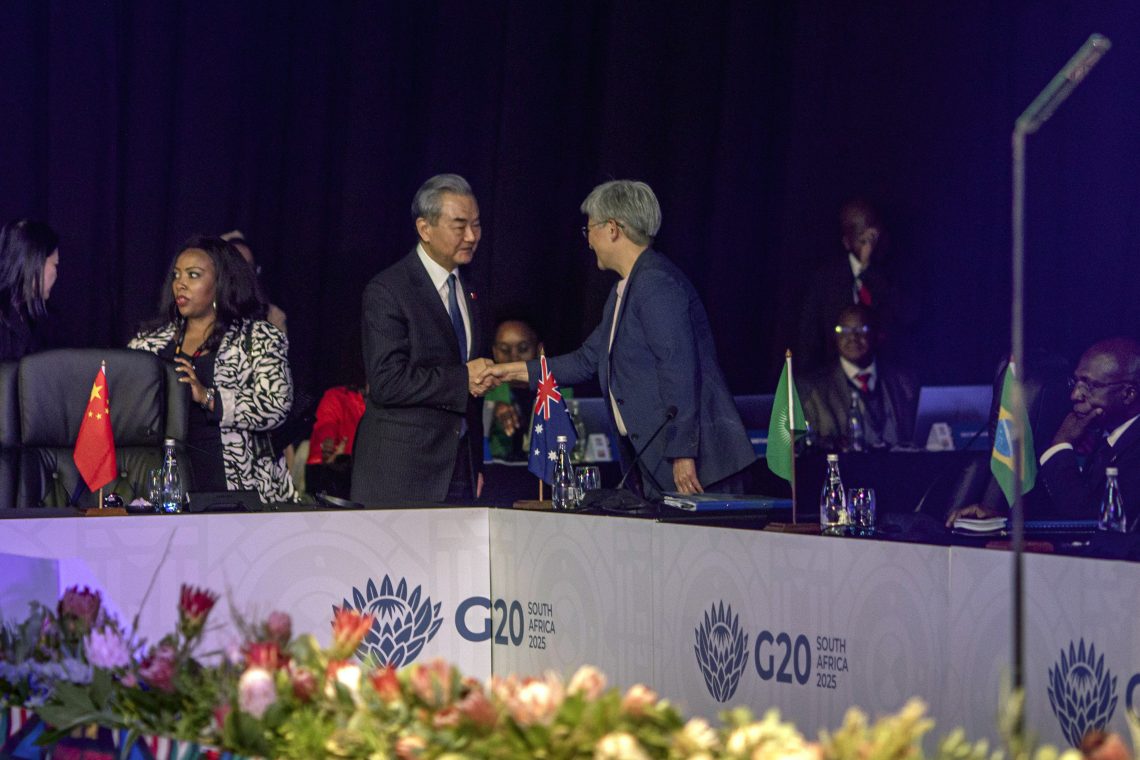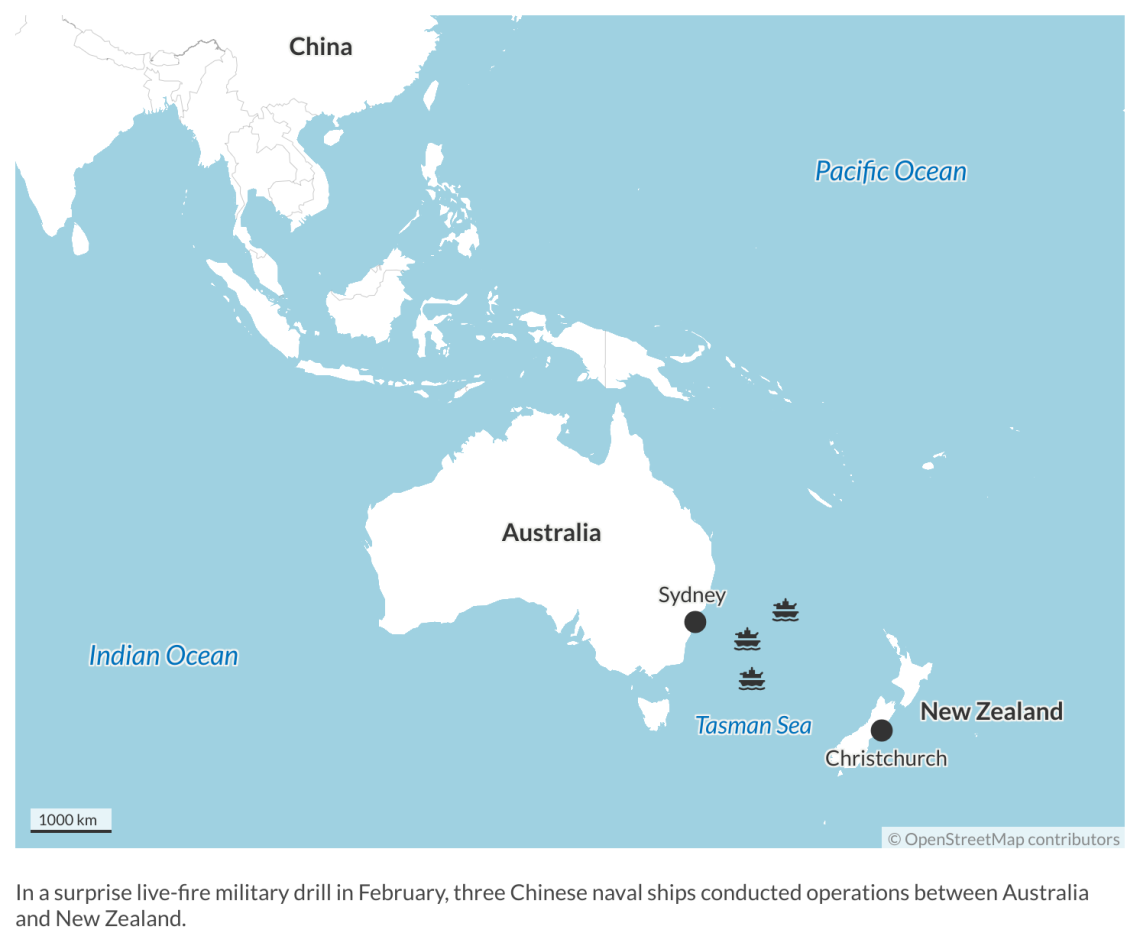China’s military expansion toward the Southwest Pacific and Oceania
Beijing is increasing military activities and economic influence in the Indo-Pacific and transforming the regional security landscape.

In a nutshell
- China’s navy challenges Australia, New Zealand and U.S. strategies
- Chinese military exercises extend beyond Taiwan into Oceania
- Beijing’s economic push includes BRI projects in Pacific Island nations
- For comprehensive insights, tune into our AI-powered podcast here
There is a particular interest in China’s recent military activities around Taiwan and their implications for the broader Indo-Pacific region. At an annual defense conference in May, United States Secretary of Defense Pete Hegseth stated, “Any attempt by communist China to conquer Taiwan by force would result in devastating consequences for the Indo-Pacific and the world.”
However, as the U.S. narrows its focus on Taiwan’s security, China is steadily expanding its military and economic interests beyond the South China Sea, increasingly encroaching on the Southwest Pacific and Oceania. Beijing’s growing influence in the Pacific is shifting the balance of power, posing a challenge to the long-standing security dominance of Western nations in the region.
Beijing is testing the limits of what its military and paramilitary forces can do without violating international law. These efforts showcase China’s military capabilities beyond its nearshore waters and are part of an ongoing effort to normalize its military activity across the Indo-Pacific.
Nevertheless, this strategy is not going unnoticed and it is encouraging countries across the Indo-Pacific region to invest more in their own defense and security capabilities.
China’s bold military moves
The Southwest Pacific serves as a crucial transit zone for military shipping, while a large volume of commercial cargo also passes through the region, including agricultural exports from Australia and New Zealand, energy shipments from Australia to the U.S. and East Asia, and much of America’s exports to the Asia-Pacific markets.
Australia and New Zealand are also two of the five members of the Five Eyes, an intelligence-sharing alliance with the U.S., Canada and the United Kingdom.
In mid-February, vessels from China’s People’s Liberation Army Navy were seen transiting key waterways such as the Torres Strait and near Papua New Guinea, including drone activity within the latter’s airspace.
Shortly after this incident, the Chinese navy announced live-fire naval exercises in the Tasman Sea between Australia and New Zealand, marking its first recorded operational engagement in this strategically sensitive area. Its task group included the guided-missile frigate Hengyang, the cruiser Zunyi and the replenishment ship Weishanhu. For nearly a month, Australian forces were on high alert as Chinese naval ships made an unannounced journey around the continent, provocatively navigating in and out of Australia’s exclusive economic zone.
The drills led to the rerouting of many international flights due to safety concerns, signaling Beijing’s disregard for established norms of transparency in global airspace and maritime safety. The sudden presence of Chinese warships near the maritime boundaries of Australia and New Zealand caught both countries’ defense establishments off guard – in fact, it was a Virgin Australia pilot who alerted Australian authorities about the Chinese live-fire drill. The incident sparked strong reactions from policymakers and military analysts, and raised questions about China’s intentions in the broader Southwest Pacific.
Facts & figures
The incident raised questions about China’s intentions in the broader Southwest Pacific. For Australia and New Zealand, both of which depend on open and secure sea lanes of communication for their economies and military coordination, Beijing’s drills underscored a rising Chinese presence in what was until recently considered a relatively insulated maritime region. The Australian 2024 National Defense Strategy highlighted concerns about China’s rapidly growing military and economic footprint in the Southwest Pacific region. Other countries across the Indo-Pacific are also aware of China’s growing military reach.
Strategically, the exercises in February indicated China’s intent to test or challenge existing security assumptions. They also suggest the possibility of a future where the Southwest Pacific, including the Tasman Sea, could become a contested zone, compelling Australia, New Zealand and their ally, the U.S., to reevaluate their strategies.
Following the incident, Australia’s Foreign Minister Penny Wong confronted her Chinese counterpart during a G20 summit, expressing concerns about the lack of prior notification for the exercises. Defense Minister Richard Marles acknowledged the exercises were legal, but also criticized the absence of prior communication, which forced the Australian Defence Force to rely on commercial pilot alerts to track activity. Opposition leaders in Australia called for a tougher response to China’s assertiveness.
New Zealand’s Foreign Minister Winston Peters called the incident a “failure” in diplomatic communication, while Defense Minister Judith Collins emphasized the strategic seriousness of the deployment, noting that the Chinese flotilla included vessels armed with ballistic missiles capable of reaching Australia. Prime Minister Christopher Luxon underscored the need to reassess New Zealand’s defense posture.

A multifaceted security strategy
Since 2022, China has intensified its military activity around Taiwan, extending beyond daily operations in the Taiwan Strait. It now includes more frequent large-scale exercises involving both the military and paramilitary forces, such as the coast guard, often featuring live-fire drills. Last year, two exercises, respectively named Joint Sword-2024 A and B, saw record-setting military activity by China’s forces.
While the focus of these forces has been around the island of Taiwan and its satellite islands, it should not be surprising to see these types of exercises now incorporating operations in regions like the Southwest Pacific.
Economic power and regional shifts
In recent years, China’s activities in the Southwest Pacific have increasingly aligned with long-term strategic, military and diplomatic interests. Beijing often presents its outreach as focusing on development, infrastructure and mutual benefit, but its actions indicate a deeper goal of reshaping the regional balance of power and challenging traditional U.S. and allied influence.
In 2019, both the Solomon Islands and Kiribati switched from diplomatically recognizing Taiwan, to officially considering it part of China. Nauru made the same decision in 2024. Following this change, the Solomon Islands also signed a security agreement with China in 2022. The deal shocked regional powers, especially Australia and the U.S., due to a clause allowing China to make port visits and conduct logistics replenishment.
Beijing is also intervening in international frameworks, leveraging its influence to shape global norms and institutions in ways that align with its strategic interests.
In May, Daniel Waneoroa, a member of parliament of the Solomon Islands, resigned from the Inter-Parliamentary Alliance on China, an international cross-party network of lawmakers that collaborates to address the challenges posed by the policies and influence of the Chinese Communist Party. Mr. Waneoroa faced persistent intimidation from the People’s Republic of China, including direct actions by its embassy in Honiara. Some Chinese officials reportedly warned of economic retaliation if he refused to leave the alliance.
Although China has not released an official policy document explicitly outlining its interests in the Southwest Pacific, its increasing economic activity in the region indicates clear strategic intent. By investing in infrastructure (especially dual-use ports which ostensibly are designed for commercial shipping but have capabilities to serve naval vessels), signing resource agreements and engaging in aid diplomacy, China is deepening its involvement with several Pacific Island nations.
Read more on China’s growing influence
- Japan modernizes its military to counter regional threats
- Global connectivity under threat
- China’s military expansion: A global power shift in the making
China’s total development support to the Pacific is suspected to have reached approximately $256 million in 2022, marking a 6 percent rise from the previous year. This growth allowed Beijing to reclaim its position as the region’s second-largest bilateral donor, behind Australia.
China’s Belt and Road Initiative (BRI) has reached most of the Pacific Islands, with Beijing offering to build infrastructure for these countries. Papua New Guinea joined the BRI during the 2018 Asia-Pacific Economic Cooperation Summit, with plans for roads, hospitals and energy infrastructure. Fiji has also been a partner in the initiative since 2018, focusing on projects related to roads, bridges and water infrastructure.
In February, the Cook Islands entered into multiple agreements with China to strengthen cooperation on various issues, including the exploration of seabed minerals. Unsurprisingly, this irked Wellington. In response, New Zealand announced the suspension of millions of dollars in aid to the small Pacific Island nation.
A notable BRI project that raises national security concerns is in Vanuatu. China funded the upgrade of the Luganville Wharf, which American and Australian officials warned could have dual-use military potential. China and Vanuatu deny these claims.
China is also expanding its digital infrastructure projects in the region. Huawei plans to construct 161 telecom towers in the Solomon Islands to support its 5G network.
Beijing’s support for infrastructure development in the Southwest Pacific has serious strategic implications, especially since digital infrastructure such as undersea cables, 5G networks and other infrastructure are closely linked to national security. Control or influence over these systems could give China access to sensitive communications, surveillance opportunities and even potential disruption capabilities during crises.
Scenarios
Likely: China increases scale and frequency of military operations in the Pacific
Countries near China are already familiar with its increasing military and paramilitary activities in the region. Taiwan sees dozens of military aircraft and naval vessel activity near its islands every day. Beijing continues to use its coast guard to harass and intimidate Philippine vessels in the South China Sea and the Japanese coast guard near the Senkaku Islands.
China’s military activities are likely to extend beyond the waters around Taiwan, the South China Sea and Japan into new areas such as Oceania and the Indian Ocean. Like the large military exercises conducted around Taiwan, China is not only expanding the scale of its military operations but also integrating various military and paramilitary forces. Beijing will not just broaden its reach but also step up the frequency of these military activities to normalize its actions.
Most likely: Australia to partner with regional partners to counter China
The growing presence of China’s navy and surprise military activities around Australia will very likely lead to two outcomes. First, Australia, the U.S. and their partners will probably conduct more freedom of navigation operations and joint drills to assert their presence. Second, these countries will likely stress an even greater need for better maritime domain awareness and real-time information sharing.
Given Canberra’s repeated concerns about Beijing’s expanding economic and diplomatic involvement in the region, it will be no surprise that Australia will work with other regional leaders, like Japan, to counter China’s economic and strategic investments.
Finally, the combination of China’s escalating military activity in the Indo-Pacific region and the diplomatic uncertainty from Washington will likely lead to more rhetoric from countries like Australia, New Zealand and others calling for enhanced domestic defense and security capabilities.
Contact us today for tailored geopolitical insights and industry-specific advisory services.







